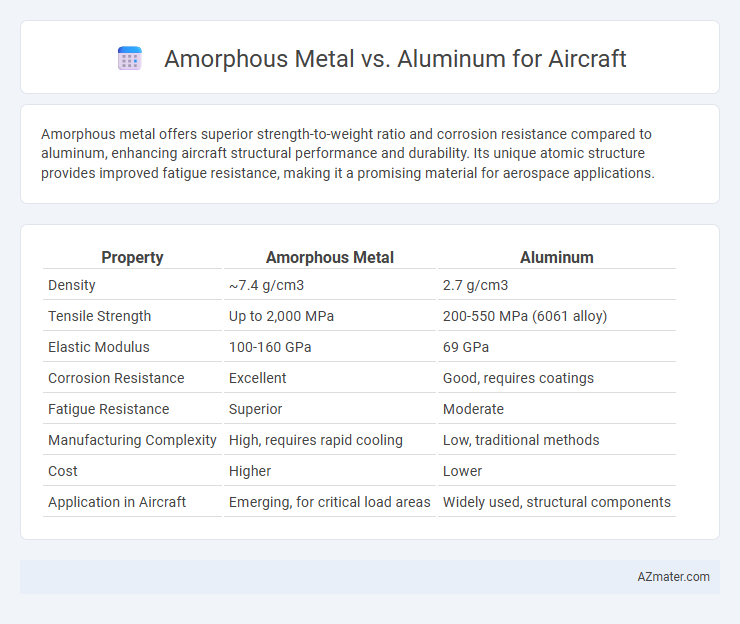Amorphous metal offers superior strength-to-weight ratio and corrosion resistance compared to aluminum, enhancing aircraft structural performance and durability. Its unique atomic structure provides improved fatigue resistance, making it a promising material for aerospace applications.
Table of Comparison
| Property | Amorphous Metal | Aluminum |
|---|---|---|
| Density | ~7.4 g/cm3 | 2.7 g/cm3 |
| Tensile Strength | Up to 2,000 MPa | 200-550 MPa (6061 alloy) |
| Elastic Modulus | 100-160 GPa | 69 GPa |
| Corrosion Resistance | Excellent | Good, requires coatings |
| Fatigue Resistance | Superior | Moderate |
| Manufacturing Complexity | High, requires rapid cooling | Low, traditional methods |
| Cost | Higher | Lower |
| Application in Aircraft | Emerging, for critical load areas | Widely used, structural components |
Introduction to Amorphous Metals and Aluminum in Aerospace
Amorphous metals, also known as metallic glasses, exhibit a disordered atomic structure that provides superior strength, corrosion resistance, and elastic limits compared to conventional crystalline materials. In aerospace, aluminum remains the dominant metal due to its lightweight, excellent machinability, and high strength-to-weight ratio, crucial for aircraft structural components. Recent advancements in amorphous metal alloys offer promising alternatives to aluminum by potentially enhancing fatigue resistance and thermal stability in aerospace applications.
Material Properties: Strength and Toughness Comparison
Amorphous metals exhibit superior strength and hardness compared to aluminum alloys, offering higher yield strength typically exceeding 2 GPa, whereas conventional aircraft-grade aluminum alloys like 7075-T6 have yield strengths around 500-600 MPa. Despite their hardness, amorphous metals possess lower toughness and are more brittle, making them susceptible to cracking under impact or cyclic loading, while aluminum alloys provide better ductility and fracture toughness essential for absorbing energy during stress. The strength-to-weight ratio of amorphous metals can surpass aluminum, but aluminum's proven fatigue resistance and damage tolerance remain critical for reliable aircraft structural components.
Weight Considerations in Aircraft Applications
Amorphous metals exhibit a higher strength-to-weight ratio compared to traditional aluminum alloys, making them advantageous for reducing overall aircraft weight without compromising structural integrity. Their low density combined with superior mechanical properties allows for lighter components that contribute to improved fuel efficiency and increased payload capacity. While aluminum remains widely used due to cost and established manufacturing processes, integrating amorphous metals presents a promising avenue for weight optimization in advanced aerospace designs.
Corrosion Resistance of Amorphous Metals vs Aluminum
Amorphous metals exhibit superior corrosion resistance compared to traditional aluminum alloys used in aircraft, due to their non-crystalline atomic structure which eliminates grain boundaries that typically act as corrosion initiation sites. This enhanced corrosion resistance reduces maintenance costs and extends the service life of aircraft components exposed to harsh environments such as saltwater and industrial pollutants. Consequently, amorphous metals offer a promising alternative in aerospace applications where durability and corrosion resistance are critical factors.
Manufacturability and Processing Techniques
Amorphous metals exhibit superior manufacturability in aircraft applications due to their ability to be processed through rapid solidification techniques like melt spinning, which produce non-crystalline structures with enhanced mechanical properties. In contrast, aluminum alloys rely on conventional casting and forging methods that require multiple heat treatments and machining steps, increasing production complexity and time. Amorphous metals' near-net-shape manufacturability and reduced machining requirements offer significant advantages over aluminum in reducing manufacturing costs and improving aircraft structural performance.
Fatigue Life and Structural Durability
Amorphous metals exhibit significantly higher fatigue life than aluminum due to their non-crystalline atomic structure, which eliminates dislocation movement and delays crack initiation. In aircraft structural applications, amorphous metals provide enhanced durability and resistance to cyclic loading, reducing maintenance frequency and improving safety. Aluminum alloys, while lightweight and corrosion-resistant, generally show lower fatigue endurance compared to amorphous metals, making the latter more suitable for critical fatigue-prone components.
Thermal Stability and Performance at Extreme Temperatures
Amorphous metals exhibit superior thermal stability compared to aluminum, maintaining structural integrity and mechanical properties at extreme temperatures often encountered in aerospace environments. Their non-crystalline atomic structure reduces grain boundary weaknesses, enhancing resistance to thermal fatigue and oxidation beyond aluminum's typical threshold of around 150degC. This makes amorphous metals highly advantageous for critical aircraft components exposed to rapid temperature fluctuations and high thermal stresses.
Cost Analysis: Production and Lifecycle Expenses
Amorphous metals, known for their superior strength-to-weight ratio and corrosion resistance, often incur higher initial production costs compared to aluminum due to complex manufacturing processes like rapid cooling and specialized casting techniques. Aluminum remains cost-effective for aircraft applications, benefiting from well-established supply chains and widespread recycling infrastructure, which reduces lifecycle expenses and supports extensive maintenance networks. Over the aircraft's operational lifespan, the reduced need for corrosion-related repairs with amorphous metals can offset some upfront costs, but aluminum's lower material and production expenses typically make it the preferred choice for cost-sensitive aerospace projects.
Environmental Impact and Recyclability
Amorphous metals, known for their unique atomic structure, offer superior corrosion resistance and longer lifespan compared to aluminum, reducing waste and environmental degradation in aircraft applications. Aluminum's high recyclability, with an energy savings of up to 95% compared to primary production, supports sustainable material reuse despite higher susceptibility to corrosion and wear. The environmental impact of amorphous metals is currently limited by energy-intensive manufacturing processes, while aluminum benefits from well-established recycling infrastructures that minimize its ecological footprint over time.
Future Prospects and Innovations in Aircraft Materials
Amorphous metals exhibit superior strength-to-weight ratios and enhanced corrosion resistance compared to traditional aluminum alloys, positioning them as promising candidates for next-generation aircraft materials. Innovations in additive manufacturing and alloy composition are accelerating the development of amorphous metal components, offering potential improvements in fuel efficiency and structural durability. Continued research into lightweight amorphous composites is expected to revolutionize aircraft design by enabling more efficient and sustainable airframes.

Infographic: Amorphous metal vs Aluminum for Aircraft
 azmater.com
azmater.com